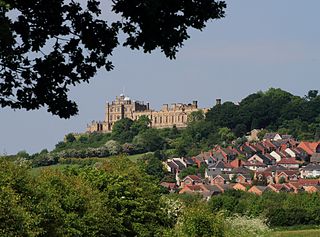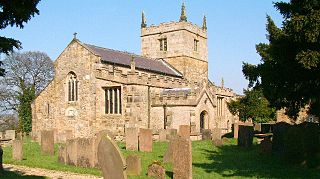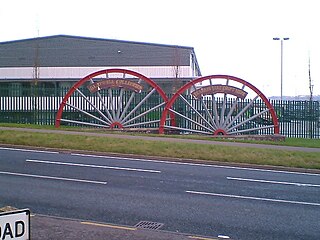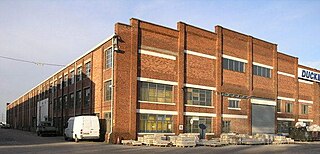
Bolsover is a market town and the administrative centre of the Bolsover District, Derbyshire, England. It is 18 miles (29 km) from Sheffield, 26 miles (42 km) from Nottingham and 27 miles (43 km) from Derby. It is the main town in the Bolsover district.

Pleasley is a village and civil parish with parts in both Derbyshire and Nottinghamshire. It lies between Chesterfield and Mansfield, 5 miles (8 km) south east of Bolsover, Derbyshire, England and 2.5 miles (4 km) north west of Mansfield, Nottinghamshire. The River Meden, which forms the county boundary in this area, runs through the village.

Bolsover District is a local government district in Derbyshire, England. It is named after the town of Bolsover, which is near the geographic centre of the district, but the council is based in the large village of Clowne to the north. The district also includes the town of Shirebrook and several villages and surrounding rural areas.

Shirebrook is a town and civil parish in the Bolsover District of Derbyshire, England. It had a population of 13,300 at the 2021 Census. The town is on the B6407 road and close to the A632 road which runs between the towns of Mansfield, Worksop and Bolsover. The town is close to the Bassetlaw and Mansfield Districts of Nottinghamshire.

Ashover is a village and civil parish in the English county of Derbyshire. It is in the North East Derbyshire district of the county. The population of the civil parish taken at the 2011 Census was 1,905, increasing to 1,959 for the 2021 census. It sits in a valley, not far from the town of Matlock and the Peak District national park.

Clowne is a town and civil parish in the Bolsover district of Derbyshire, England. The population was 7,590 at the 2011 Census and 7,755 at the 2021 Census. It lies 9 miles (14 km) north east of Chesterfield and 7 miles (11 km) south west of Worksop and is mentioned in the Domesday Book as Clune. The name is derived from the Celtic Clun for a river.

Ault Hucknall is a village and civil parish in the Bolsover district of Derbyshire, England. The population of the civil parish at the 2011 census was 1,053.

Blackwell was a rural district in Derbyshire, England from 1894 to 1974. It was created under the Local Government Act 1894 based on that part of the Mansfield rural sanitary district which was in Derbyshire.

Bramley Vale is a village in Derbyshire, England, south of Bolsover. It is in the civil parish of Ault Hucknall.

Elmton with Creswell is a civil parish in the Bolsover district in Derbyshire, England. It covers the villages of Elmton, Creswell and Creswell Model Village. According to Census data in 2001, Elmton with Creswell parish had a population of 4,755, and in 2011 had a population of 5,550. The town lies on the border with Nottinghamshire.

Langwith is a close group of six villages crossing the Derbyshire-Nottinghamshire border, on the River Poulter about 2 miles (3.2 km) from Warsop, and about 4 miles (6.4 km) from Bolsover on the A632 road, south of Whaley Thorns. The population is listed under the Derbyshire civil parish of Langwith and the Nottinghamshire civil parish of Nether Langwith.

Duckmanton is a village within the civil parish of Sutton cum Duckmanton, in North East Derbyshire, between Bolsover and Chesterfield. Duckmanton is a long scattered village, running north and south, usually designated Long, Middle and Far Duckmanton, of which Middle Duckmanton is 4 miles (6.4 km) east from Chesterfield and 2.5 miles (4.0 km) west from Bolsover.

Palterton and Sutton is a former railway station between Palterton and Sutton Scarsdale, Derbyshire, England.
The Doe Lea branch is a mothballed railway line in Derbyshire, England. It connected the Derbyshire towns of Chesterfield, Staveley and Bolsover to the Nottinghamshire town of Mansfield. It also had a branch line to Creswell via the Derbyshire town of Clowne.

St John the Baptist's Church, Ault Hucknall, is a Grade I listed parish church in the Church of England in Ault Hucknall, Derbyshire.

St Leonard's Church, Scarcliffe, is a Grade II* listed parish church in the Church of England in Scarcliffe, Derbyshire.
The Hundreds of Derbyshire were the geographic divisions of the historic county of Derbyshire for administrative, military and judicial purposes. They were established in Derbyshire some time before the Norman conquest. In the Domesday Survey of 1086 AD the hundreds were called wapentakes. By 1273 the county was divided into 8 hundreds with some later combined, becoming 6 hundreds over the following centuries. The Local Government Act 1894 replaced hundreds with districts. Derbyshire is now divided into 8 administrative boroughs within the Derbyshire County Council area.
Scarcliffe is a civil parish in the Bolsover District of Derbyshire, England. The parish contains five listed buildings that are recorded in the National Heritage List for England. Of these, one is listed at Grade II*, the middle of the three grades, and the others are at Grade II, the lowest grade. The parish contains the villages of Scarcliffe and Palterton and the surrounding area. The listed buildings consist of a church, a small country house, and three farmhouses.















